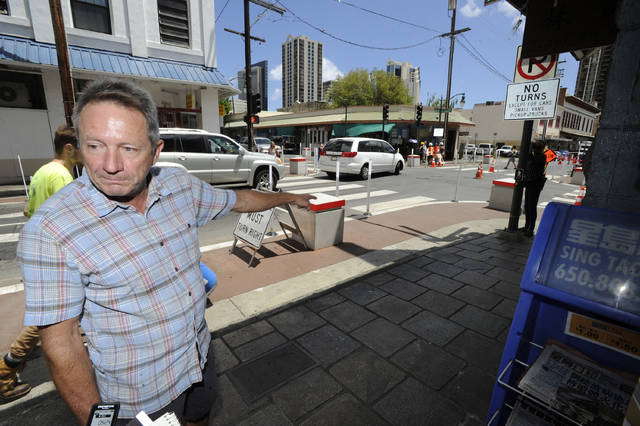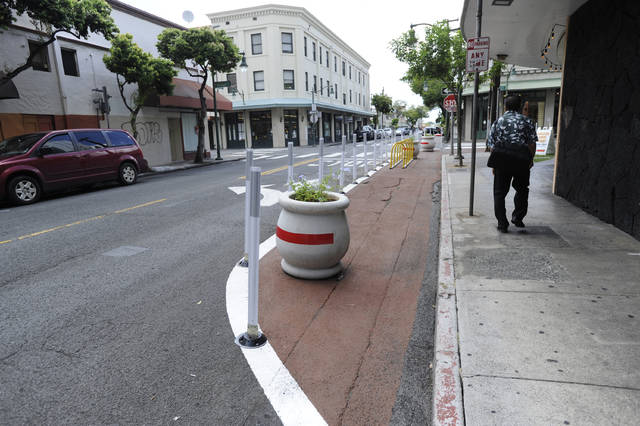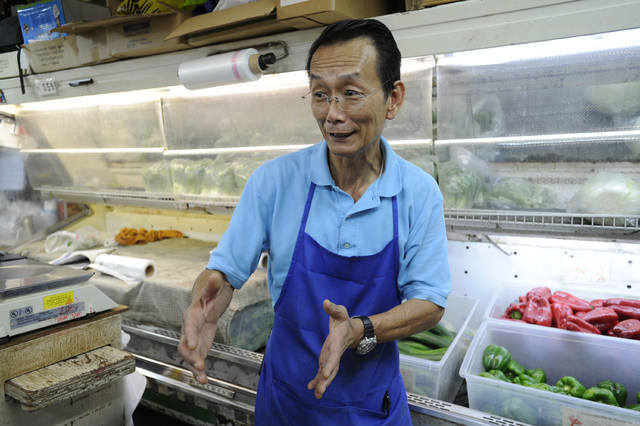Experimental curb extensions in Chinatown draw fire from some businesses

BRUCE ASATO / BASATO@STARADVERTISER.COM
The city says no legal parking spaces were taken away by the three-month pilot project. Property owner Oren Schlieman, above, says some business owners might not be able to survive it.

BRUCE ASATO / BASATO@STARADVERTISER.COM
The city says no legal parking spaces were taken away by the three-month pilot project, above.

BRUCE ASATO / BASATO@STARADVERTISER.COM
Paul Min of You Market in the Kekaulike Market said he appreciates the effort to encourage walking in Chinatown, including the street bulb-outs. “They want Chinatown to be people-friendly. To do that, you need a wider sidewalk,” he said.



Call it the fight over the Chinatown tradition of the quick pickup where motorists park curbside, even if it’s illegal, and then run out to grab a lei or box of manapua.
Several petitions are circulating urging the Caldwell administration to remove 11 traffic bulb-outs or curb extensions that were installed along key intersections of Chinatown several weeks ago. Area City Councilwoman Carol Fukunaga and former Gov. Neil Abercrombie have also joined the chorus of those who want the extensions out now.
But city officials, who emphasize that no legal parking spaces or loading zones were taken away for the three-month pilot project, are asking the community to give the experiment at least 90 days before passing final judgment.
Designed as a traffic-calming measure, a bulb-out extends the sidewalk at an intersection, thus shortening the distance a pedestrian needs to cross.
Sam Say, owner of M.P. Lei Shop at Maunakea and Pauahi streets, said Friday that he’s seen at least a 20 percent drop in sales since the bulb-outs were installed. Now he’s making arrangements with customers ahead of time so they can do a fast, drive-by exchange, in the through-traffic lane.
One of Say’s regular customers told him she goes to him because she wants to help out small business but that “if she passes three or four times and cannot find parking, she’s going to go to Safeway to buy it.”
Don't miss out on what's happening!
Stay in touch with breaking news, as it happens, conveniently in your email inbox. It's FREE!
Say said from his store he now sees near collisions “all day long.” He also questioned whether the bulb-outs hamper emergency vehicles, noting that vehicles trying to clear a path for an ambulance or firetruck have nowhere to pull over.
When told that no legal public parking stalls or loading zones were taken away, Say balked. “In Chinatown, who does legal parking anyway? Nobody. Here it’s just come and go.”
Chinatown property owner Oren Schlieman said some businesses are losing so much in sales they may not be able to survive the three-month project.
Schlieman said pedestrians don’t know they can now step onto the bulb-outs to wait to cross. “We’re trained to use the sidewalk,” he said.
Instead, the bulb-outs have added to the vehicular congestion along Maunakea Street, partly because the extensions make it difficult for larger vehicles to make a turn, he said. He showed the Honolulu Star-Advertiser photos of a Honolulu Fire Department ladder truck crossing far into the lane of oncoming traffic while turning right from Maunakea Street onto Pauahi Street.
A sign on Maunakea Street warns larger vehicles not to attempt a right there, but another sign nearby states, “Right lane must turn right.”
Adding to the bottleneck at Maunakea Street has been an awning renovation project at the River of Life building on the makai-Ewa end of the Pauahi Street intersection. That has blocked one of the two through lanes down Maunakea Street.
The project began a week after the bulb-outs were placed, Schlieman said.
Most of the proprietors nearest the bulb-outs who spoke to the Star-Advertiser said they’ve seen a loss of at least 20 percent since the end of June.
Deth Soulatha, owner of Hong Fa Market on Maunakea Street, said customers are used to stopping their vehicles in front of his shop so they can lug 25-pound bags of rice into the back seat. Older patrons, especially, “they cannot pick it up.”
The curb in front of Hong Fa, just mauka of the Pauahi Street intersection, was not a legal loading zone to begin with. But with barriers blocking it, no vehicles can access it, and his customers now need to haul bags of rice several blocks to a municipal parking lot, Soulatha said.
Quynh Mar Chong, owner of the restaurant Rice Paper, next to Hong Fa, said much of her business consists of takeout pho and sandwiches. Besides a drop in business there, her delivery people now have to walk their merchandise several blocks because they have nowhere in front of her store to park, she said.
She suggested designating the entire lane of Maunakea Street between Beretania and Pauahi streets a loading zone.
Jillian Jakahi, owner-manager of the Char Hung Sut manapua shop, said there is a loading zone near the store’s Pauahi Street entrance, but a bulb-out on one side of it has made it difficult for delivery vehicles to park there, she said.
“The impact to our customers and our delivery people is huge,” Jakahi said.
Not all Chinatown merchants oppose the bulb-outs. Paul Min of You Market in Kekaulike Market said the bulb-outs are helpful to older shoppers, many of whom need walkers and wheelchairs to get by. The sidewalks are congested because the city allows vendors in Chinatown to use a portion of the sidewalk as storefront space, he said.
“They want Chinatown to be people-friendly,” Min said. “To do that, you need a wider sidewalk.”
Min said he’s been to many meetings involving transit-oriented development for the area as well as other planning proposals where sidewalk extensions were discussed and supported. (A March 2016 Chinatown action plan identified “pilot curb extensions at key Chinatown intersections” as a top priority.)
Min said having people park and walk by different stores will benefit all merchants and shoppers in the long run. “Walk around,” he said. “Go to different places.”
City officials said they are listening to the concerns of merchants and residents. They’ve made a number of changes to the initial project, and adding designated loading zones is in the plans.
Hong Li, a city project engineer and manager for the pilot community project, said the primary goal is to improve public safety. “We want people driving into Chinatown to slow down and pay attention to pedestrians crossing.”
Three public meetings have been held since 2015 specifically to discuss the bulb-outs and the other planned changes, Li said, adding that he also personally went door to door and spoke to each of the business owners.
“It takes time for people to get used to it, so we put it up for three months,” he said.
Mike Packard, the city’s Complete Streets coordinator, said he is tasked with a longer-term project that will place permanent traffic improvements in Chinatown. That project will take into consideration the lessons from Li’s study, he said.
Over a 10-year period, Chinatown has seen an annual average of six collisions involving pedestrians, Packard said.



